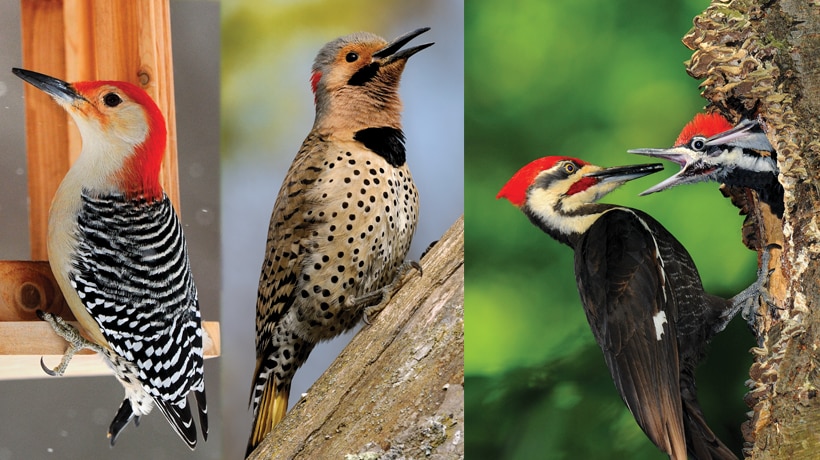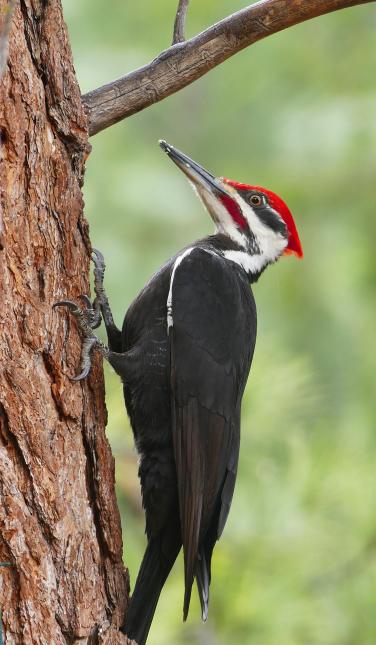Checking Out Woodpeckers in Florida Habitats: Where to Detect These Birds
Wiki Article
Woodpeckers: A Comprehensive Guide to Understanding These One-of-a-kind Birds
Woodpeckers, with their distinct actions and physical attributes, have long captivated the curiosity of ornithologists and nature fanatics alike. From their balanced drumming echoing via the woods to their exceptional adaptations for scaling tree trunks with ease, these birds present a remarkable research study in avian biology. What truly sets woodpeckers apart is not simply their striking appearance however additionally their important role in preserving the fragile equilibrium of ecological communities. As we discover the intricate makeup, varied varieties, and ecological relevance of woodpeckers, a much deeper recognition for these distinct birds and the enigmas they hold unfolds.
Woodpeckers' Drumming Habits
Woodpeckers exhibit a rhythmic and precise drumming behavior that offers numerous crucial features in their everyday lives. This behavior is mainly related to communication, territory protection, and foraging. The unique drumming noise is created by the quick pecking of their beaks versus difficult surfaces such as tree trunks, branches, and even steel things.Communication is an important aspect of woodpecker actions, and drumming plays a substantial function in this process. Woodpeckers make use of drumming to develop their existence, attract friends, and preserve contact with their companions and children. The frequency, strength, and duration of drumming sequences share certain messages to other woodpeckers in the location.
Along with interaction, woodpeckers utilize drumming behavior for region defense. Woodpeckers in Florida. The loud and repetitive drumming functions as an alerting to potential burglars, signaling that the location is already asserted. By establishing their area with drumming, woodpeckers reduce the probability of conflicts over beneficial resources such as food and nesting websites
Moreover, woodpeckers likewise employ drumming as a foraging technique. The balanced pecking assists them situate insects concealing beneath the bark of trees by producing vibrations that interrupt the target's concealment. This behavior showcases the versatility and ingenuity of woodpeckers in utilizing their drumming abilities for numerous vital objectives.
Distinct Adjustments for Tree Climbing
Having mastered the art of drumming to interact, protect area, and forage, woodpeckers have progressed distinct adaptations that promote their remarkable climbing up capabilities in their arboreal environments. Woodpeckers have zygodactyl feet, with 2 toes aiming forward and 2 toes directing backwards. These tail feathers offer security and equilibrium, making it possible for woodpeckers to maneuver up tree trunks with accuracy and dexterity.Furthermore, woodpeckers have effective neck muscle mass and an unique skull framework that aid in their climbing capabilities. Their solid neck muscular tissues permit them to rapidly eat tree bark without experiencing whiplash, while their thick skull and small brain function as shock absorbers, safeguarding them from the effect of repeated drumming. These adaptations jointly make it possible for woodpeckers to navigate the vertical world of trees with performance and grace.

Role of Woodpeckers in Communities
Playing a crucial duty in forest ecological communities, woodpeckers add substantially to the balance and wellness of their habitats through their unique behaviors and communications with various other varieties. One of the key ecological functions of woodpeckers is their function in managing insect populations. By foraging for insects under the bark of trees, woodpeckers help regulate bug populations, stopping outbreaks that might harm the general health and wellness of the woodland. In addition, woodpeckers create tooth cavities in trees that work as crucial nesting sites for a variety of other bird varieties, advertising biodiversity within the environment.Additionally, the drumming and vocalizations of woodpeckers play an essential role this website in communication and territory facility. These noises not only offer to bring in mates however also aid specify limits between different woodpecker regions, lowering problems and promoting an unified coexistence within the woodland neighborhood. Generally, the presence of woodpeckers in woodland ecological communities highlights their value as keystone species, affecting the characteristics and working of these environments in complex means.
Anatomy: Specialized Beaks and Feet
In the detailed internet of forest environments, the specialized beaks and feet of woodpeckers are Continued vital adaptations that allow them to fulfill their vital ecological roles. Woodpeckers possess special physiological functions that are especially made to aid them in their foraging and nesting behaviors.One of the most distinct feature of woodpeckers is their strong, chisel-shaped beaks. These beaks are completely adapted for boring into wood to uncover pests, larvae, and sap concealed beneath the bark of trees. The strong muscular tissues and sturdy structure of their beaks permit woodpeckers to peck at a rate of approximately 20 times per secondly without causing damage to their skulls.
Additionally, woodpeckers have specialized feet that help in their acrobatic climbing abilities. Their feet have two toes pointing forward and two toes pointing backward, providing a strong grip on vertical surfaces (Woodpeckers in Florida). This unique foot arrangement, along with tight tail plumes that work as a supportive prop, allows woodpeckers to hold on to tree trunks and branches easily while they search for food or dig deep into nesting cavities
Woodpecker Types Variety
Woodpeckers are a varied group of birds located throughout different communities worldwide, with over 200 known varieties showing adjustments to different settings. Woodpeckers have actually developed to live in an array of atmospheres, from woodlands and forests to grasslands and deserts, each offering unique difficulties that have affected the development of distinct woodpecker varieties.These adjustments make it check that possible for woodpeckers to forage efficiently in their particular environments, reducing competition amongst varieties and promoting particular niche distinction. In addition, geographic isolation and historic variables have played a role in shaping the circulation and diversity of woodpecker species, leading to the wide range of specialized adaptations seen in these interesting birds.

Verdict
To conclude, woodpeckers are interesting birds that exhibit one-of-a-kind drumming habits, specialized adaptations for tree climbing, and play vital duties in communities. Their anatomy, consisting of specialized beaks and feet, permits them to grow in their environment. With a varied variety of woodpecker species discovered worldwide, these birds are important for keeping the health and wellness and balance of woodlands and woodlands. Recognizing and appreciating the complexities of woodpeckers can provide beneficial insights right into the environment.Report this wiki page